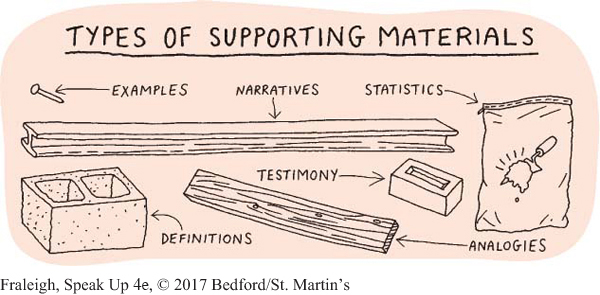Develop Supporting Materials
Once you’ve selected your main points, develop supporting materials—information that bolsters and fleshes out the claims made in each of those points. There are several types of supporting materials, including examples, definitions, testimony, statistics, narratives, and analogies. You can generate supporting materials internally by brainstorming and externally by conducting research.
Page 47

Brainstorming is the process of quickly listing every idea that comes to mind, without evaluating its merits, in order to develop a substantial list of ideas. To brainstorm potential supporting materials, ask yourself questions such as “What do I know about my topic?” and “What do I think is most important or interesting about this topic?” List all the responses to these questions that come to mind. Your goal is to create a diverse list of many possible ideas, not to make a final decision about which ones you will use.
Research is the process of gathering information from libraries, quality online sources, and interviews with authorities on your topic. Through research, you obtain information from experts that will enhance your understanding of the topic and strengthen your speech’s credibility. Even if your instructor requires less research for your first speech than for later assignments, you should still do a little research to answer any questions you have about your topic area.
As you research, be sure to save a copy of any useful material you unearth. Also keep track of the bibliographic information for the sources of your information, noting the following items so that you can incorporate them into your outline and your speech:
The author: The writer or sponsoring organization of a book, an article, or an online entry
The author’s credentials on the subject: Her or his job title, relevant education or job experience, or academic or institutional affiliation
The name of the source: The title of a book, the title of an article and the name of the periodical or newspaper it ran in, or the name of a person you interviewed
Page 48
The publication date: The copyright date for a book you used, the publication date of a periodical or newspaper you researched, the date you accessed a Web site, or the date you conducted an interview
The page(s) on which you found relevant information in a printed source or the URL of an online source
After brainstorming and researching supporting materials for your main points, select the supporting materials that would most interest your listeners and help them grasp what you’re saying about your topic.